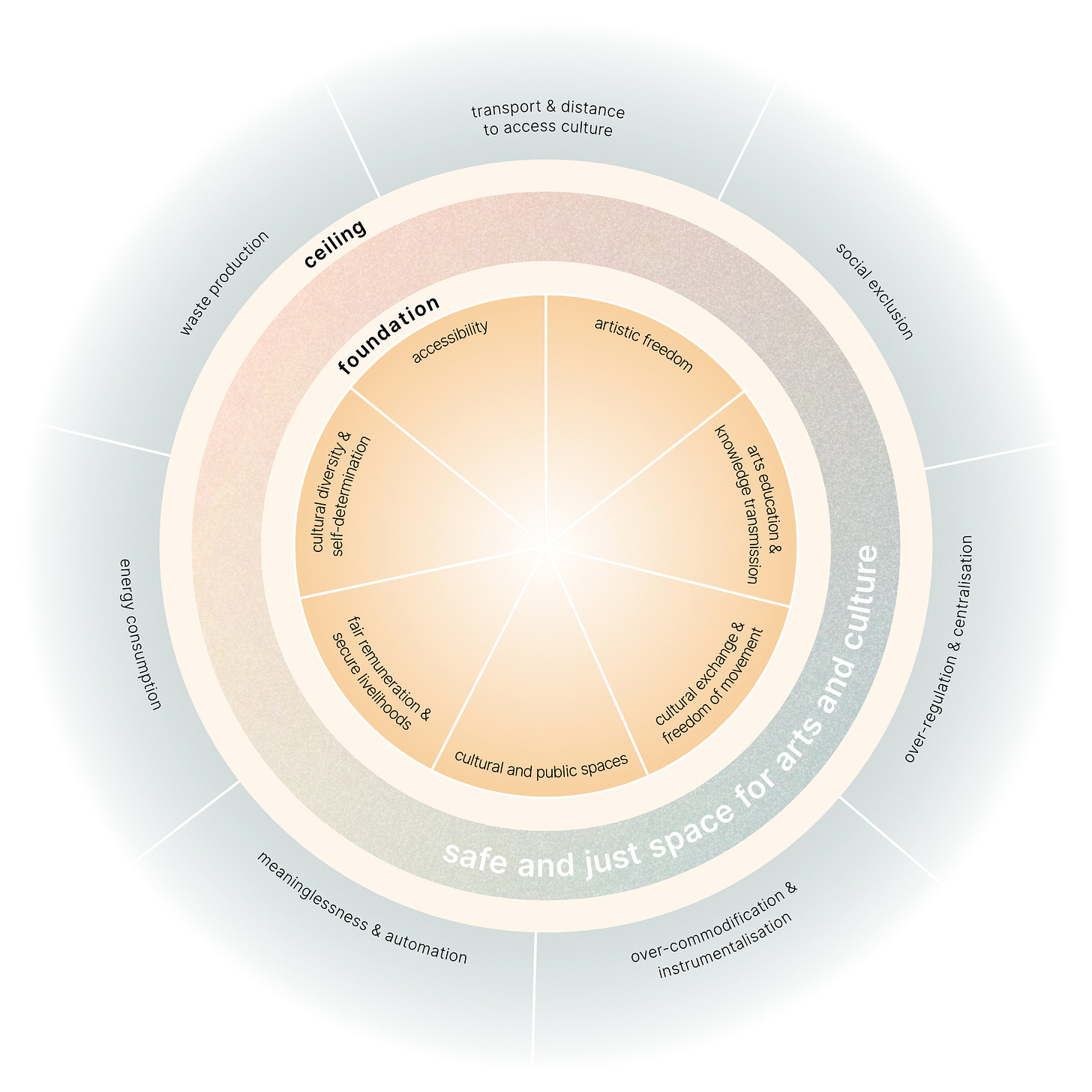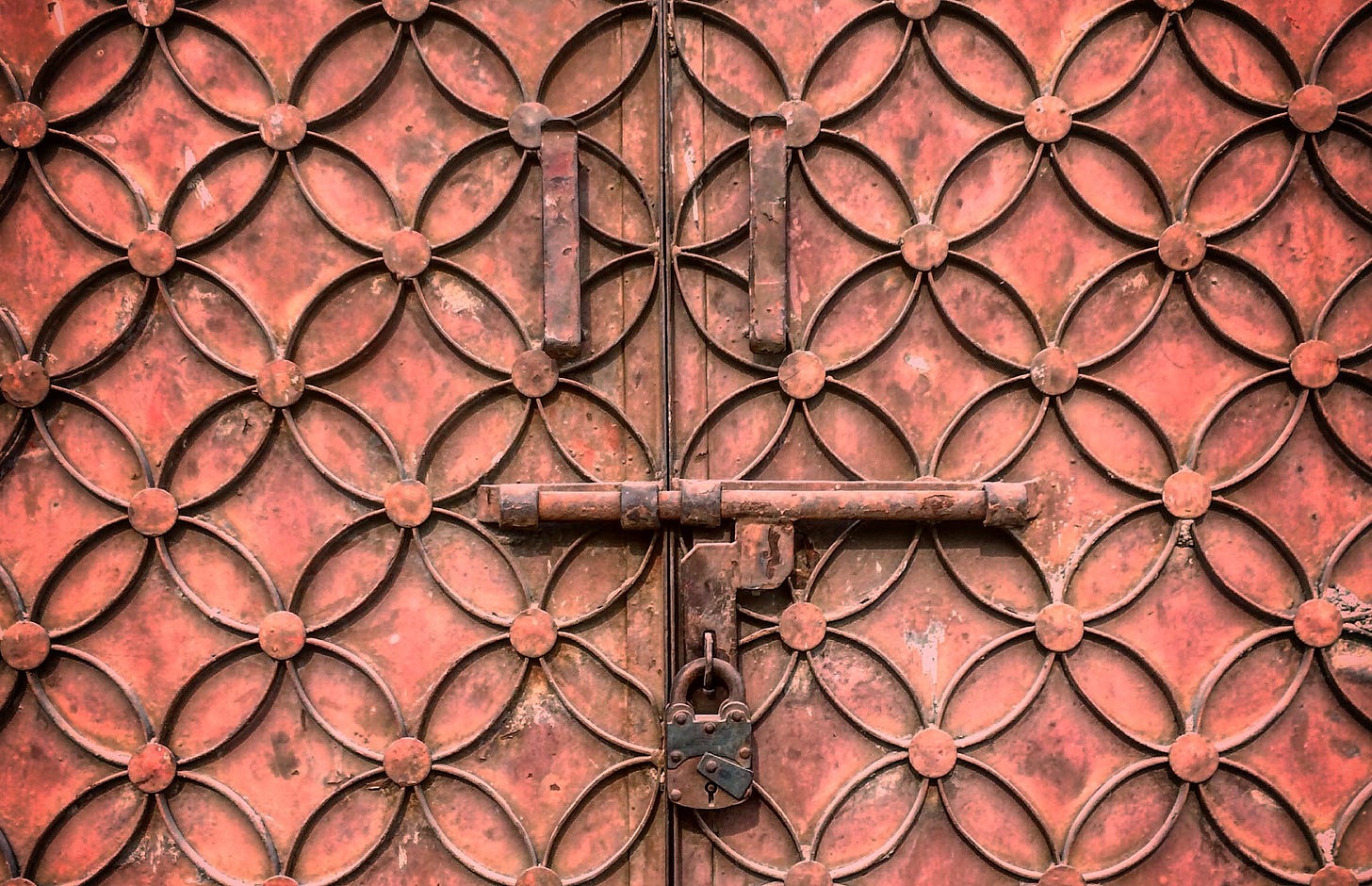curious patterns #27
Tales of artistic mushroom networks, cultural doughnuts, and metaverse prototyping.
curious patterns is an online publication of curated news around arts and culture, impact and evaluation, sustainable development and regenerative futures, and where these all intersect. My name is Kai Brennert, I am based out of Cambodia 🇰🇭, and I run the evaluation, research and policy consultancy edge and story.
Welcome, subscribers at Arup 🇬🇧, British Council 🇬🇧, Doc Servizi 🇮🇹, Espacio Checoeslovaquia 🇨🇱, Finance Innovation 🇫🇷, Imperial War Museums 🇬🇧, Institut für Auslandsbeziehungen (ifa) 🇩🇪, La 27e Région 🇫🇷, the Liverpool City Region 🇬🇧, Newcastle University 🇬🇧, Open Theatre 🇬🇧, Phare Studio 🇰🇭, Rosetta Life 🇬🇧, the City of San Juan 🇵🇷, Storm2 🇩🇪, TrueMotion 🇳🇱, and the Trust for Indigenous Culture and Health (TICAH) 🇰🇪
📣 IT’S OUT! It has taken what feels like forever but it was worth it! Our British Council-commissioned report The Missing Foundation: Culture’s Place Within and Beyond the UN Sustainable Development Goals is now available. The title speaks for itself, but I feel inclined to teaser the section headlines just for the fun of it:
→ Confusion in the Echo Chamber
→ Rhetoric Alignment Hurts Culture and the SDGs
→ Playing the Game Whilst Changing the Rules
Alright, enough talking – download the report in all its 46-pages glory here!
🇹🇭 My buddy Roc applied the Public Private People Partnership approach recently. How? Welcome to metaverse co-design and rapid prototyping for urban development.
🇲🇲 Next door in Myanmar, a fearless activist develops a mobile game to fund the resistance against the military junta. Shout-out to all badass IT (h)activists out there!
🚨 2023 is the year of counter museums, it seems. First, UNESCO and Interpol set up a museum for stolen artefacts, and now, Barcelona has a museum of censored art.
🇵🇪🇮🇩🇴🇲 The Regenerative Travel Impact Awards got the memo that any form of regeneration must have culture at its heart. Finalists look like great initiatives.
🇧🇩 Gotta love a good cultural tourism campaign showing off the diverse indigenous peoples whose rights are actually heavily curtailed. Bangladesh cultural diplomacy fail.
🇰🇵 How about an optimistic futures science fiction decree? North Korea sure has understood the power of literature, including state-sanctioned literary theory.
🇮🇶 Storytelling like this can also be used the other way round. Iraq’s representation in the Marvel comic book multiverse is mostly troubling, but thankfully, not entirely.
🛢️ 200 new cultural attractions by 2030 in Saudi Arabia – gotta use the oil cash while it’s still there, I suppose. The Gulf countries are entering their cultural investment era.
🇦🇴 And if you’re curious how another big oil country is handling their cultural and creative industries, check out this mapping of Angola and its many, many challenges.
🇳🇬 What do you do as a politician when the film industry is campaigning against you? Revoke licenses of all actors, directors, and producers. That’s Kannywood for you.
🏦 Just wrote about public development banks discovering CCIs in cp#26. Now, here we go with a new development banks’ coalition for culture x SDGs. Curiously, non-development banks AFD and Enabel are also in the mix. (h/t Greta)
🍩 Possibly the tastiest analogy in economic theory
Kate Raworth’s Doughnut Economics from 2017 really inspired a lot of people and bureaucracies to re-think what economy means (how we engage with each other), what it should do (“bring humanity into the global sweet spot”), and how to get there (maintain a social foundation and don’t overshoot the ecological ceiling). She has seven lessons and one incredibly strong analogy (the doughnut, duh!). I’m not going into a full-blown review of the book but instead tell you that it is absolutely something you should read if you have even the faintest interest in systems change.
One thing was conspicuously absent from Kate’s doughnut: culture. What to do? Put on the thinking hat, make some green tea, and grab the notebook. Of course, applying the doughnut to arts and culture or trying to integrate culture into the doughnut is not a novel idea. For example, Mark Robinson has already had a shot at a cultural doughnut. Below is my first sketch at an arts doughnut, i.e. a starkly zoomed in version of what is needed and what we must be careful of not overdoing in the arts:
In relation to The Missing Foundation research I shared above, this arts doughnut sketch obviously suffers from similar pain points as for example a stand-alone culture SDG. Feel free to use and further develop, edit or remix this sketch. Would absolutely love to hear what you think and/or come up with in response.
🍩 And here is an entirely unrelated doughnut fun fact: In the USA, and with even higher density in California, a lot of doughnut shops are run by Cambodians 🇰🇭
IMPACT
🧸 Observation bingo sounds like a great method for participatory evaluation. And Nicole McNeilly tried it out in her exploration of play in evaluation. I feel like there is incredible potential in using play, perhaps also gamification and even worldbuilding, in evaluation contexts. This has certainly sparked my interest to dig deeper. I love how Nicole is continuously documenting her evaluation experiments as it really contributes to open community learning. Thanks a bunch, Nicole, and I look forward to the evaluation card game!
🧬 Instead of data on culture, think of data as culture. I love a good dataviz and I keep sharing great resources about data on culture. The Open Data Institute is taking it a step further and commissioned a bunch of contemporary artworks that use or respond to certain datasets (like NSA interviews, UK divorce rates, news reports on the recession or the environmental data transmitted by a buoy), leaving the artists to ponder perspective, format, and messaging. There are some absolutely brilliant pieces among the 109 works featured on the ODI’s website, working with 25 (!) different types of data. More of that, please.
🛍️ Your one-stop-shop for measuring social impact of culture. Alright, so this report / toolkit / advocacy document / godknowswhatelse is a lot. From theorisation, methodological approaches, and an indicator collection, via a contextualisation of pilot findings and policy recommendations, all the way to an advocacy manifesto – MESOC has got it all, it seems.
Rather than working with homogeneous result indicators, it is recommended to adapt the set of transition variables and related proxies for building indicators to each specific case.
A fairly large list of proxy indicators to guide you can be accessed here (you need to click on the individual elements in the diagram). To have a tool that recognises and measures culture beyond economic impact – in this case, social impact – is the authors’ response to the instrumentalisation of culture by policymakers, which I applaud. However, I hope it’s accessible enough…
🟠 And for a little laugh, here are four satirical Venn diagrams that perfectly describe nonprofit life, including data-driven decision making, donor relations, and meeting frustrations.
RESEARCH | REPORTS | TOOLKITS
🌀 Objectivity is its own limitation. BAM – mic drop! Seriously, Manulani Aluli-Meyer manages to express so many things I deeply resonate with but never really found the words to articulate. I am grateful to her for sharing these. Her article, Changing the Culture of Research: An Introduction to the Triangulation of Meaning (starting on page 263), has been around for a while, but I assure you that it is as timely as ever. I am only going to say that the triangulation she is talking about refers to what some understand as body, mind, and spirit – others may call it empiricism, epistemology, and hermeneutics. Read more for yourself. Here’s a little teaser that might make you chuckle a little:
Culture is defined as best practices of a group of people.
🍄 Welcome to the curious world of mushrooms. I am only halfway through Let’s Become Fungal! Mycelium Teachings and the Arts by Yasmine Ostendorf-Rodríguez, but I can already shout out a full and unreserved recommendation for this book. It weaves between oral histories and biological phenomena, arts and activism, politics and spirituality, and then sprinkles nuggets of personal reflection on what this means for the arts in between – all through the lens of fungi, mycelia, and mushrooms. In fact, Yasmine explores and connects knowledge not unlike what Manulani calls for in her article above.
🇺🇳 The 2023 Global Sustainable Development Report does not demonstrate any understanding of the cultural dimension of development. That’s one of the findings of UN Special Rapporteur for Cultural Rights, Alexendra Xanthaki, in her latest report. She is not joking around. She firmly lays out the flaws of multilateral international development and trade bodies in recognising culture and cultural rights. An absolutely fascinating report (and dare I say advocacy instrument) that I warmly recommend skimming – lots of great arguments and examples. Or, at the very least, read the conclusion in which she drops this bombshell:
International development and trade organizations are currently failing to respect cultural rights: IMF rejects its responsibility to respect cultural rights; WIPO has not fully grasped the wide concept of culture and connections between all its work and cultural rights; the World Bank does not press States to respect cultural rights when they clash with economic development or other interests; WTO prioritizes other rights and interests; UNESCO has not yet fully operationalized cultural rights in its work on the cultural dimension of development; and the Office of the United Nations High Commissioner for Refugees and other organizations have not fully engaged with their possible linkages with cultural rights.
In comparison, the UNESCO report on culture and sustainable development presented at the same UN General Assembly session in July reads like the complete opposite: everything is rosy and we’re on a good trajectory. Make of that what you will.
ART IN BETWEEN
⛑️ Who would have thought that zooming is a legitimate storytelling mechanism. Check it out, the International Committee of the Red Cross (ICRC) decided to take an infinite zoom illustration approach to explain the concept of neutrality in delivering humanitarian aid. Nice way to use art as an educational tool.
🍎 Apple also used some fancy video storytelling in their latest sustainability reporting. At first I liked it, then I read this critique, and now I am not so sure anymore.
WHAT ELSE?
🕸️ There are way too many good resources out there. And while I try curate some for you here as best as I can, I am also acutely aware of the fleetingness of it all. Perhaps some time I put together a public Notion document or Airtable database with all the toolkits and open source knowledge relevant to arts, culture, and the creative industries for better futures. In the meantime, you might find solace in the resource collection of the Distributed Design platform: designing for good canvases, makerspace workshop models, modular exhibition systems, and loads more.
🤖 Chaos factor still too high. Or is it? Agents is a cute, quirky, thoughtful, beautiful, and imaginative inquiry into the relationship between humans and a possible future of living with artificial intelligence and extended reality. Five and a half minutes you won’t regret. Now I want my own Glitchy…
🎙️ Economic value could just be a derivative of creating social and environmental value. If we deliberately design the future that way. That’s what Christian Bason of the Danish Design Centre argues among many, many other things in this episode of a very exciting new podcast by my buddy Nadim with the excellent title of Curiosity That Matters. In fact, there are six dimensions Christian introduces in his book Expand: Stretching the Future by Design that is discussed in the podcast. I have already read the book, so many of the ideas aren’t entirely new to me, but if you haven’t, I recommend letting Christian and Nadim walk you through how we could better design the future.
Please forward this newsletter to a friend, and do reach out: kai@edgeandstory.com







